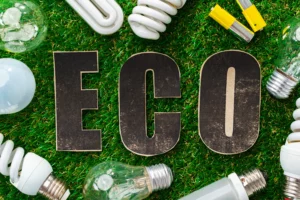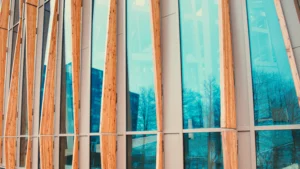Are you familiar with the Bullitt building in Seattle, Washington? It’s a six-story commercial building designed to be both energy efficient and environmentally responsible. What makes it so green is all of its features, these include solar panels, a green roof, rainwater harvesters, being built out of sustainable materials, and its high indoor environment quality. It truly is a model for green architecture.
“Green architecture is a philosophy of architecture that advocates sustainable energy sources, the conservation of energy, the reuse and safety of building materials, and the siting of a building within the consideration of its impact on the environment.” In simpler terms, it’s a design approach that aims to minimize the impact of buildings on the environment, like its carbon footprint for example, while creating healthy and comfortable indoor space.
Energy Efficient
One of the key principles of green architecture is energy efficiency. This means that buildings are designed to reduce energy consumption. One of the most common ways is through solar power, particularly passive solar.
A passive solar design is the use of the sun’s energy for heating and cooling indoor living spaces. Going back to the Bullitt building as an example, their offices are heated and cooled with a radiant heat system. Without getting into the nitty-gritty of the system, it dumps heat through a system of water tubes that go underground. In the winter, the system does the reverse and uses the heat of the ground to heat up the building. Another example is solar panels. For the Bullitt building, these panels produce as much electricity as it uses, which gives it its Living Building certificate.
The benefit of this setup is that it’s self-sufficient. The summer sun is strong enough to store extra energy in batteries or onto an electrical grid. A radiant heat system allows for the heating and cooling of a building without using much electricity, which is generated by solar panels.
A limitation of this type of setup is dependent on the environment. For example, during the winter months, the solar panels can’t get enough sunlight to power the whole building without having stored energy over the summer. The solar panels also have to be configured in a way that gets the building the most amount of sunlight possible. This leads to the problem of location, as not all locations are suitable for an energy-efficient setup. Adding onto that, another limitation for both personal and commercial use, is the capacity of the battery cells available on the market, with cost determining how much energy can be stored.
Sustainable Materials
Another important factor in green architecture is the use of sustainable materials. This includes materials that are sourced locally, made from renewable resources, or are not harmful to the environment.
The Bullitt building’s structure was made with materials that were all sourced within 600 miles. Concrete is an infamous carbon emitter, so the use of concrete was limited to the base of the building. The wood was sourced locally and when bigger beams were needed, they took smaller timber and glued them together, aptly named glu-lam, and used those for much of the structure of the building.
The main benefit of using sustainable materials is that they benefit the environment. Using materials that are readily available instead of importing materials is better for the environment. There’s no excessive use of fossil fuels in order to transport the materials and the building can start without much delay.
The cons of using sustainable materials is the expertise needed to use certain materials. This may raise the project’s price as you may need to bring in specialists or utilize special techniques to achieve similar results to more traditional non-ecofriendly building materials.
Indoor Environmental Quality
Indoor environmental quality (IEQ) refers to the indoor conditions in a building related to the health of its inhabitants. Factors like air quality, lighting, temperature, and ergonomics are taken into consideration when thinking about IEQ.
In order to improve the IEQ of the Bullitt building, the developers put in a building management system that controls many of the quality of life settings of the building. Even before the management system kicks in, windows and shades facing towards the sun allow the building to be lit with natural light during the day, but the shades are there if the sunlight is ever too harsh.
The advantage of increasing indoor environmental quality equates to elevated levels of comfort and ergonomics of the building inhabitants. Whether it’s a commercial or residential building, those who use the building every day will benefit from the better conditions they have inside the building.
Another disadvantage of IEQ is the added upfront cost. Some of the green IEQ changes cost more and require special teams in order to build or operate them.
Green Building Rating System
Green buildings have a rating system that indicates whether or not a building was designed and constructed with environmental responsibility in mind. Two globally accepted rating systems include LEED and BREEAM.
LEED stands for Leadership in Energy and Environmental Design, while BREEAM is short for Building Research Establishment Environmental Assessment Methodology.
BREEAM is the oldest rating system for a building’s environmental sustainability, while LEED is newer. The main difference between the two rating systems is how they go about rating the buildings, homes, or neighborhoods. BREEAM uses licensed assessors who examine the place, while LEED has the designers of a building send them the building specifications and data.
If factors such as energy efficiency, water conservation, indoor environmental quality, and the use of sustainable materials are all found to be adequate, the building gets its accreditation.
The Wrap Up
Green architecture is an important aspect when discussing sustainable design and has the potential to reduce the environmental impact of buildings while still allowing for healthy and comfortable indoor spaces. As we continue to face changes in the climate and environment, green architecture provides a solution to creating a more sustainable future.




